Regeneration of myelin sheaths of normal length and thickness in the zebrafish CNS correlates with growth of axons in caliber
- PMID: 28542521
- PMCID: PMC5444792
- DOI: 10.1371/journal.pone.0178058
Regeneration of myelin sheaths of normal length and thickness in the zebrafish CNS correlates with growth of axons in caliber
Abstract
Demyelination is observed in numerous diseases of the central nervous system, including multiple sclerosis (MS). However, the endogenous regenerative process of remyelination can replace myelin lost in disease, and in various animal models. Unfortunately, the process of remyelination often fails, particularly with ageing. Even when remyelination occurs, it is characterised by the regeneration of myelin sheaths that are abnormally thin and short. This imperfect remyelination is likely to have implications for the restoration of normal circuit function and possibly the optimal metabolic support of axons. Here we describe a larval zebrafish model of demyelination and remyelination. We employ a drug-inducible cell ablation system with which we can consistently ablate 2/3rds of oligodendrocytes in the larval zebrafish spinal cord. This leads to a concomitant demyelination of 2/3rds of axons in the spinal cord, and an innate immune response over the same time period. We find restoration of the normal number of oligodendrocytes and robust remyelination approximately two weeks after induction of cell ablation, whereby myelinated axon number is restored to control levels. Remarkably, we find that myelin sheaths of normal length and thickness are regenerated during this time. Interestingly, we find that axons grow significantly in caliber during this period of remyelination. This suggests the possibility that the active growth of axons may stimulate the regeneration of myelin sheaths of normal dimensions.
Conflict of interest statement
Figures
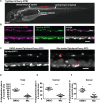
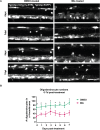
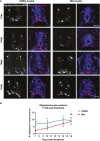
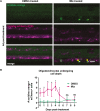
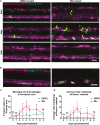
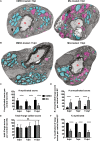
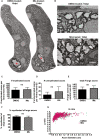

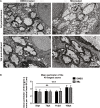
Similar articles
-
Zebrafish regenerate full thickness optic nerve myelin after demyelination, but this fails with increasing age.Acta Neuropathol Commun. 2014 Jul 15;2:77. doi: 10.1186/s40478-014-0077-y. Acta Neuropathol Commun. 2014. PMID: 25022486 Free PMC article.
-
Thin myelin sheaths as the hallmark of remyelination persist over time and preserve axon function.Proc Natl Acad Sci U S A. 2017 Nov 7;114(45):E9685-E9691. doi: 10.1073/pnas.1714183114. Epub 2017 Oct 24. Proc Natl Acad Sci U S A. 2017. PMID: 29078396 Free PMC article.
-
The role of oligodendrocytes and oligodendrocyte progenitors in CNS remyelination.Adv Exp Med Biol. 1999;468:183-97. doi: 10.1007/978-1-4615-4685-6_15. Adv Exp Med Biol. 1999. PMID: 10635029 Review.
-
Individual axons regulate the myelinating potential of single oligodendrocytes in vivo.Development. 2011 Oct;138(20):4443-50. doi: 10.1242/dev.071001. Epub 2011 Aug 31. Development. 2011. PMID: 21880787 Free PMC article.
-
Pushing Forward: Remyelination as the New Frontier in CNS Diseases.Trends Neurosci. 2016 Apr;39(4):246-263. doi: 10.1016/j.tins.2016.02.004. Epub 2016 Mar 7. Trends Neurosci. 2016. PMID: 26964504 Review.
Cited by
-
Insights Into Central Nervous System Glial Cell Formation and Function From Zebrafish.Front Cell Dev Biol. 2021 Nov 29;9:754606. doi: 10.3389/fcell.2021.754606. eCollection 2021. Front Cell Dev Biol. 2021. PMID: 34912801 Free PMC article. Review.
-
An automated high-resolution in vivo screen in zebrafish to identify chemical regulators of myelination.Elife. 2018 Jul 6;7:e35136. doi: 10.7554/eLife.35136. Elife. 2018. PMID: 29979149 Free PMC article.
-
Building a (w)rapport between neurons and oligodendroglia: Reciprocal interactions underlying adaptive myelination.Neuron. 2021 Apr 21;109(8):1258-1273. doi: 10.1016/j.neuron.2021.02.003. Epub 2021 Feb 22. Neuron. 2021. PMID: 33621477 Free PMC article. Review.
-
Radiologic Lag and Brain MRI Lesion Dynamics During Attacks in MOG Antibody-Associated Disease.Neurology. 2024 May 28;102(10):e209303. doi: 10.1212/WNL.0000000000209303. Epub 2024 May 6. Neurology. 2024. PMID: 38710000 Free PMC article.
-
Oligodendrocyte Neurofascin Independently Regulates Both Myelin Targeting and Sheath Growth in the CNS.Dev Cell. 2019 Dec 16;51(6):730-744.e6. doi: 10.1016/j.devcel.2019.10.016. Epub 2019 Nov 21. Dev Cell. 2019. PMID: 31761670 Free PMC article.
References
-
- Ginsberg MR, Rubin RA, Falcone T, Ting AH, Natowicz MR. Brain transcriptional and epigenetic associations with autism. PLoS ONE. 2012;7: e44736 doi: 10.1371/journal.pone.0044736 - DOI - PMC - PubMed
-
- Nave K-A, Ehrenreich H. Myelination and oligodendrocyte functions in psychiatric diseases. JAMA Psychiatry. 2014;71: 582–584. doi: 10.1001/jamapsychiatry.2014.189 - DOI - PubMed
-
- Périer O, Grégoire A. Electron microscopic features of multiple sclerosis lesions. Brain. 1965;88: 937–952. - PubMed
MeSH terms
Grants and funding
LinkOut - more resources
Full Text Sources
Other Literature Sources
Molecular Biology Databases

